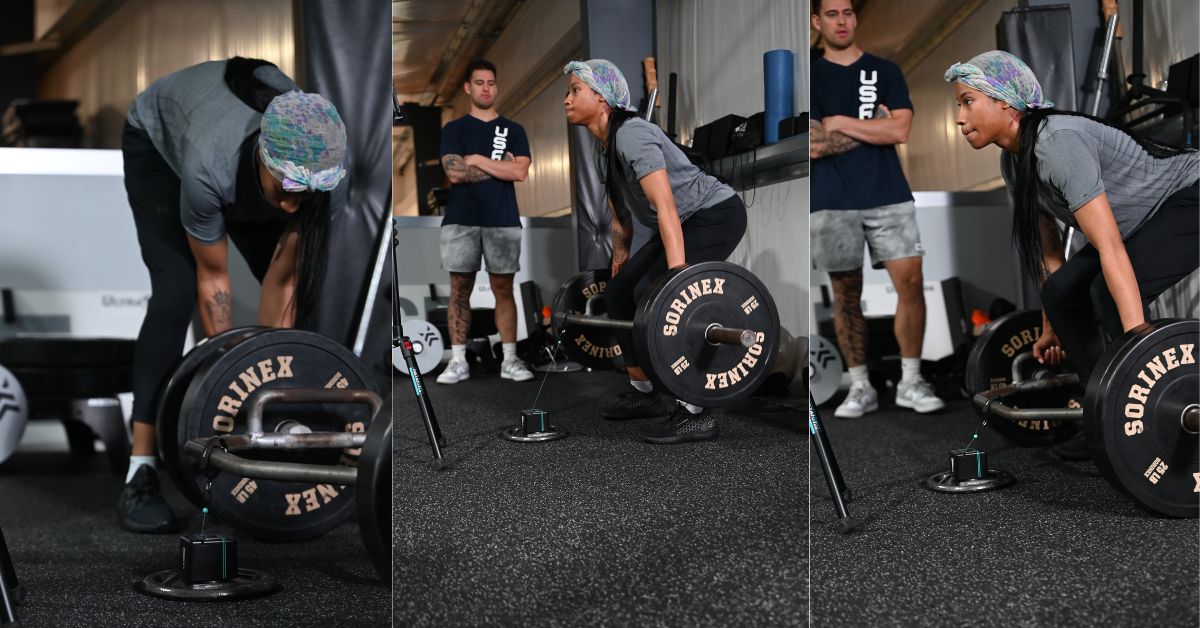
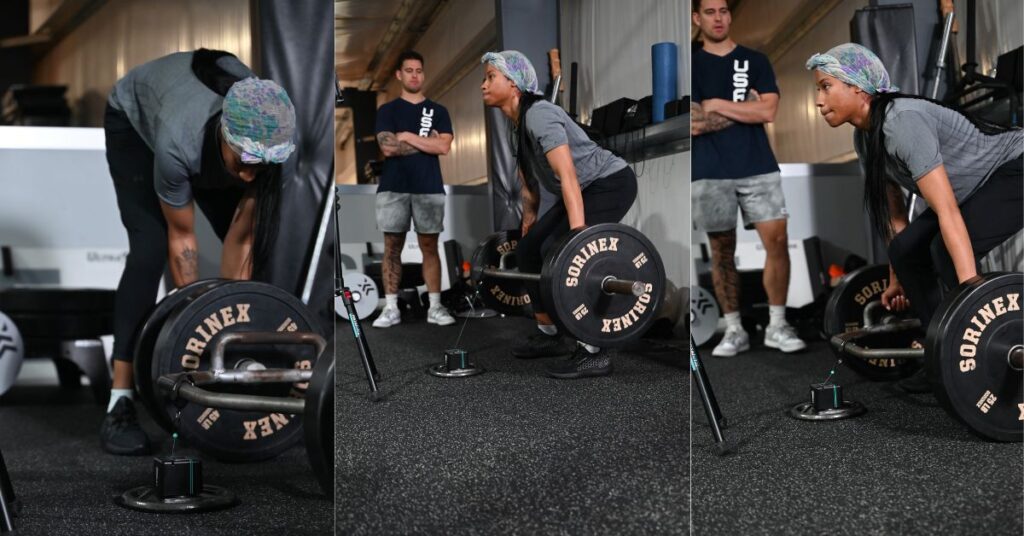
By now, all of us perceive the error within the phrase “damage prevention” coaching, however we additionally perceive the idea and its well-intentioned origin. We undoubtedly, completely, positively can NOT prepare to 100% stop sports activities accidents—not taking part in sports activities is the one solution to stop sports activities accidents.
What we CAN do is make the most of the expertise and advances in teaching to assist our athletes cut back sure danger elements which can be controllable variables in accidents. Qualities like motion fluency, fatigue, coaching quantity, correct use of kit, and work capability are all issues that coaches can affect and assist athletes optimize, which, in flip, reduces the danger of sure accidents.
IFTTT means if this, then that. It’s a time period utilized in software program that refers back to the connecting of a number of apps and platforms to automate chain reactions. If this occurs, then set off that, that, and that to occur routinely.
That is how I view the idea of utilizing coaching to cut back damage danger. Select ideas and programming that serve an preliminary objective but additionally result in these automated chain reactions.
I firmly believe VBT can play a significant role in mitigating risk factors that could lead to common basketball injuries such as ankle sprains, tendonitis, and muscle strains, says @JustinOchoa317. Click To Tweet
That is the place velocity-based coaching (VBT) comes into play, and I firmly consider that VBT can play a major position in mitigating danger elements. Once more, not eliminating damage—not even lowering damage. Merely lowering danger elements that might result in widespread basketball accidents resembling ankle sprains, tendonitis, and muscle strains.
Frequent Basketball Accidents
Sprains, strains, tendonitis, and tendinopathy are the most typical basketball accidents at each degree. We regularly give attention to the tragic accidents, resembling ligament tears, tendon ruptures, or damaged bones, however these don’t occur at as excessive of a charge as the previous. It’s simply what we hear about within the headlines.
In each basketball locker room, there’ll just about all the time be an athlete battling at the very least a kind of nagging accidents.
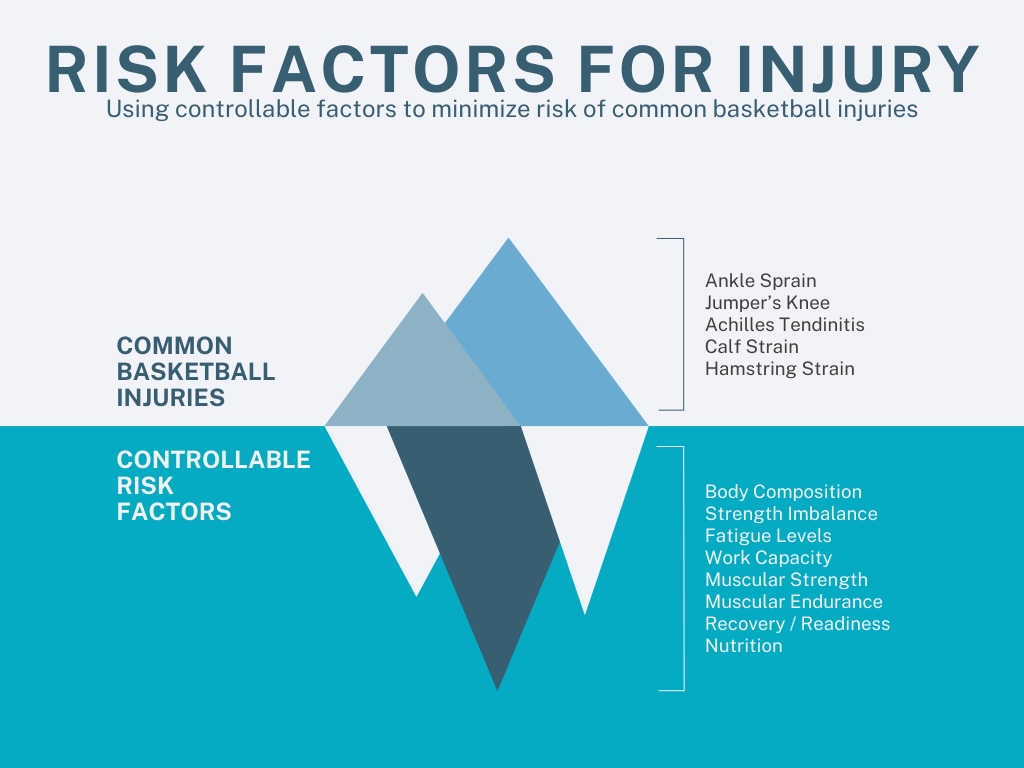
Ankle Sprains
The commonest instance is an ankle sprain. Dying, taxes, and hoopers spraining an ankle are the ensures in life. Are you able to stop them? No. Are there controllable danger elements? Sure.
Uncontrollable elements can be the dreaded “coming down on somebody’s foot” ankle sprain. You may chalk these as much as unhealthy luck.
Different widespread sprains, whether or not from a pointy minimize or a easy transfer they’ve accomplished 1000’s of occasions, will be essentially the most mysterious and irritating accidents for basketball gamers. Many occasions, we will tighten up the laces and use adrenaline to get by means of the ache, however some sprains simply level clean take us out, and there’s no trying again from there.
Because it pertains to coaching, one of many greatest controllable danger elements of ankle sprains is definitely physique composition. Analysis exhibits that we must always place emphasis on guaranteeing that athletes have and preserve the suitable physique composition.
As it relates to training, one of the biggest controllable risk factors of ankle sprains is actually body composition, says @JustinOchoa317. Click To Tweet
This may occasionally appear apparent on the earth of soccer, the place a number of the athletes are strategically “chubby” or play a place that entails one-on-one fight each single rep, however it’s additionally legitimate for basketball gamers.
Physique composition may be very strongly associated to conditioning, and conditioning may be very strongly associated to fatigue ranges. We’ll speak about fatigue and its affect on damage all through this text, however an athlete’s physique composition will symbolize their taking part in weight, too.
On many basketball frames, an additional 10 kilos can actually convey a number of undesirable load and power into a number of the cuts, vegetation, and landings that occur 1000’s of occasions all through the season. If the athlete is just not structurally able to withstanding these forces, that might begin to take a toll on joint and tissue well being.
Two different main danger elements are an imbalance in ankle flexor energy and poor dynamic stability.
And lastly, fatigue. Fatigue—which is a typical denominator in all accidents—is a crucial danger issue due to the domino impact it could possibly have on different features, resembling proprioception, muscle activation, and neuromuscular response time.
Tendonitis/Tendinopathy
Within the realm of tendon accidents, basketball gamers generally endure from tendonitis or tendinopathy in both the Achilles or patellar tendon.
When hoopers do an excessive amount of too quickly, that painful tenderness under the kneecap is a significant signal of Jumper’s Knee. Normally, we see instances of this at the highschool degree after vacation breaks as a result of a fast lower in exercise adopted by a fast improve in exercise. On the extra superior ranges, it may be extra of an overuse damage that has a number of further elements at play.
Like ankle sprains, physique composition is a crucial danger issue for each Achilles and patellar tendon dysfunction. The primary perpetrator to those accidents, although, is a fast improve or spike in loading that overwhelms the present capability of the tendon or area of the physique.
That is why you may all however assure seeing a number of of those points pop up throughout coaching camp or early within the pre-season. If an athlete didn’t adequately put together for the sport’s calls for, that load tolerance imbalance will undoubtedly flare up as Achilles tendonitis or patellar tendon ache.
Muscle Strains
Relating to muscle strains, the calves and hamstrings are the widespread areas of the physique that basketball gamers will injure. As talked about earlier than, fatigue, physique composition, and elevated loading are key danger elements of muscle strains. Muscle energy can also be a key issue. Because the well-known Westside Barbell saying goes, “Weak issues break.”
And no, a basketball participant doesn’t must be as sturdy as a Westside Barbell powerlifter. Really, I might extremely advise towards aiming for these ranges of energy, however having a decent degree of relative energy will present a resiliency and robustness to the athlete that may really impression their longevity.

Strained muscle mass will be scary for basketball gamers as a result of they’re so sharp and quick—the damage can really feel like one thing a lot worse within the second. We see this on a regular basis—particularly on the professional degree—the place there is a component of showmanship as nicely. A participant goes down after an ungainly transfer, and the group goes useless silent.
Followers, coaches, and teammates all base their assumptions on the participant’s response…and it seems as if their profession might have simply ended.
The participant limps off the courtroom on their very own energy, goes again to the locker room for 12 minutes, then comes again out and finishes the sport with a triple double.
That illustrates the quick ache, panic, and severity of a muscle pressure acutely—and it’s even worse when it turns into a continual damage or a recurring one. Many of those danger elements go hand-in-hand and layer with one another. These danger elements all overlap, and the kicker is that the No. 1 danger consider ALL of those accidents is having a earlier damage.
The kicker is that the #1 risk factor in ALL of these injuries is having a previous injury, says @JustinOchoa317. Click To Tweet
So, a earlier sprained ankle is a danger issue for calf muscle pressure. And a previous calf muscle damage is a danger issue for an Achilles damage.
So, what can we do? Attempt to preserve these danger elements minimized by all means. And we will attempt to quantify these efforts by utilizing VBT.
Utilizing VBT to Reduce Threat Components
You should utilize velocity-based coaching for lots of issues in sports activities efficiency coaching, however at its core, I merely take a look at it as a quantification system. VBT quantifies motion velocity throughout coaching, which permits coaches to leverage real-time information to make knowledgeable selections on load, quantity, train choice, and depth in an adaptive method.
VBT programs like Vitruve will be carried out into any program and instantly make a optimistic impression as a result of they provide coaches goal info.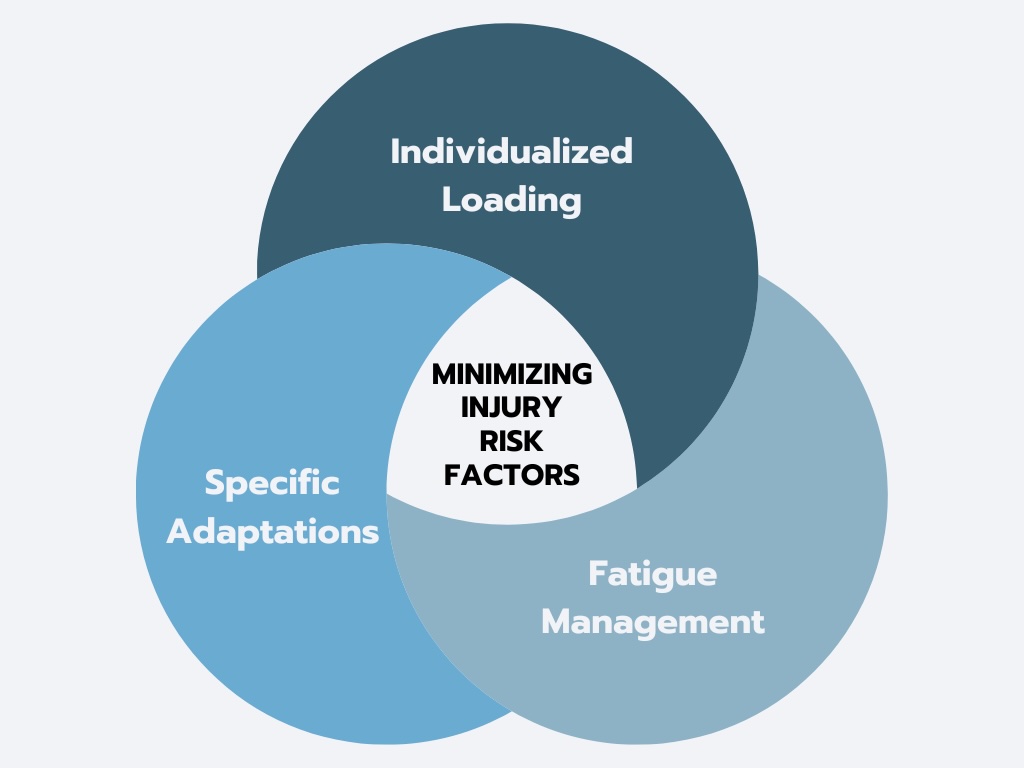
There are three important keys to VBT on the subject of damage danger minimization:
- Individualized load prescription.
- Fatigue and restoration monitoring.
- Focused neuromuscular diversifications.
1. Individualized Load Prescription
Exact loading strategies are an enormous good thing about utilizing VBT. In contrast to percentage-based packages or perceived effort monitoring, the suggestions from the lifting information is goal and distinctive to the athlete. This strikes the needle for us by way of damage danger discount as a result of acceptable loading of lifts results in proficient execution with much less compensatory motion.
Rapid increase in load and weakness are two major contributors to the risk factors of tendon injuries & muscle strains. Using VBT to prescribe individualized loads can directly influence these factors. Click To Tweet
If we revisit the danger elements of tendon accidents and muscle strains, fast improve in load and weak point are two main contributors. By utilizing VBT to prescribe individualized hundreds, we will immediately affect these elements.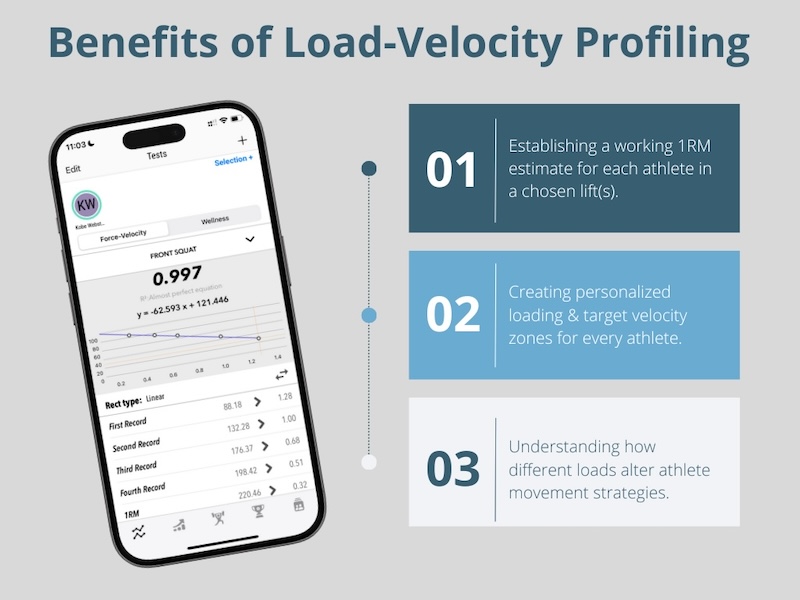
One useful device for load prescription is a load-velocity profile. I take advantage of the usual L/V profile protocol constructed into the Vitruve app; nonetheless, there are exterior spreadsheets that coaches can use as nicely.
An L/V profile offers a baseline for every athlete by way of what hundreds are related to what velocity ranges in any given carry. This technique also can predict a fairly correct 1RM, which supplies coaches the choice to make the most of that for prescribing load as nicely all through a program.
An L/V profile requires the athlete to carry out 4–5 units of 1–5 reps at more and more heavier hundreds. These reps illustrate the inverse relationship between load and velocity, making it a novel profile for every athlete that may assist coaches perceive what qualities an athlete may have to boost.
Most significantly, the L/V profile establishes a baseline of bar speeds at varied hundreds—and the way the athlete’s motion seems at every load. That is what may help with the loading prescription most as a result of, based mostly on that information, coaches can program units for both goal bar speeds or goal hundreds and appropriately assign volumes for these units which can be in keeping with the athlete’s present capability.
Utilizing this technique to show the athlete to progressive overload all through a program checks two vital bins for us with respect to damage danger.
- Progressive: Assures us that athletes are NOT experiencing a fast spike in weight room-related hundreds that will trigger tendon ache or dysfunction.
- Overload: Assures us that athletes ARE creating energy over time, serving to them adapt to coaching.
Are you able to do that with out VBT?
Positive. Lifters did it for many years.
However are you able to exactly and objectively quantify the coaching and handle the info with out VBT?
NOPE.
2. Fatigue and Restoration Monitoring
One other factor you may exactly and objectively quantify with VBT is fatigue degree. Not solely can we use VBT to take a look at readiness to coach, however on a micro degree, we will additionally take a look at intra-set fatigue.
With the ability to management the micro helps affect the macro. In different phrases, monitoring fatigue day by day may help cut back the over-accumulation of fatigue over the course of a program.
Once more, in the entire damage dangers we recognized, fatigue was repeatedly an element. Very not often have we seen basketball gamers endure non-contact accidents at first of a sport or apply: that’s after we are most primed for efficiency, and fatigue is at a low degree.
It’s normally in these ugly fourth quarters or towards the tip of a tricky apply after we see these unlucky accidents.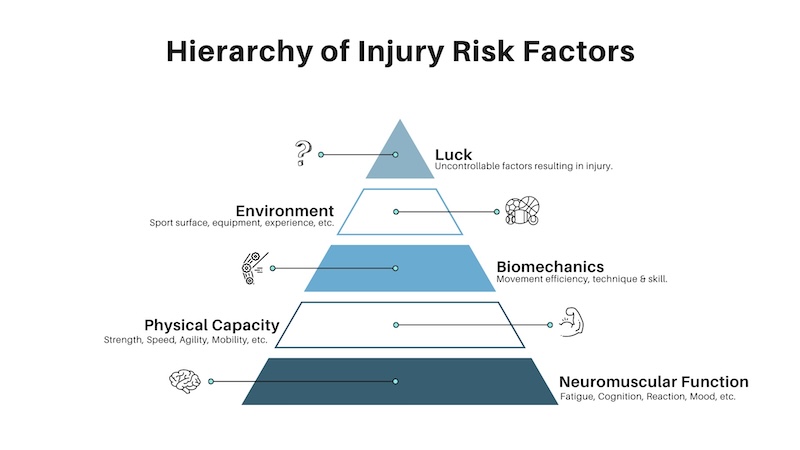
On the micro degree, one of the crucial impactful instruments constructed into the Vitruve app is the intra-set fatigue monitor. Velocity loss throughout a set is an goal solution to measure fatigue, and we all know from analysis that extra is just not all the time higher.
Coaching to failure was as soon as believed to be one of the best ways to get stronger—then, the brink modified to at-or-near failure. Now that now we have instruments like Vitruve and different VBT units to assist us really quantify velocity loss, the research present that failure might happen round 30%–40% velocity loss—the drop-off between the primary rep and the worst rep.
Due to the work of Pareja-Blanco in 2016, it’s clear that exterior of pure hypertrophy, there isn’t a profit of coaching at 40% velocity loss. When studied towards a 20% velocity loss group over an eight-week program, the 20% group had related energy positive aspects, higher dash positive aspects, and higher leap positive aspects and did so with 40% much less quantity over the course of the research.
Higher outcomes with much less quantity, much less fatigue, and fewer danger of damage? Seems like an absolute no-brainer to me.
Whether it’s built into the app or needs to be monitored manually by a coach or athlete, the velocity loss within a set is a critical metric when it comes to fatigue management with athletes. Click To Tweet
So, whether or not it’s constructed into the app or must be monitored manually by a coach or athlete, the rate loss inside a set is a vital metric to concentrate to on the subject of fatigue administration with athletes—which, in flip, can support us in lowering different damage danger elements which can be associated to fatigue.
Some useful ways in which I’ve carried out this idea into my program embrace:
- Utilizing Vitruve’s built-in characteristic to alert the athlete after they’ve reached a 20% velocity loss. The app will flash pink and make a loud noise, reminding the athlete what now we have already mentioned about velocity loss. It doesn’t matter what, the subsequent rep would be the final rep of that set.
- Assigning velocity-loss cut-off units. As a substitute of assigned reps, we estimate and assign the perfect load for a rep vary and goal bar speeds for these reps, and instruct the athlete to carry out as many reps as attainable till they hit 20% or extra in velocity loss—then cease the set.
- The above ideas are extra strength-based; I assign a ten% velocity loss for power- or speed-based work. This helps preserve the reps very highly effective and quick, with excessive bar speeds, and even additional reduces fatigue accumulation throughout extra neurologically taxing carry alternatives.
- And lastly, trying on the common velocity of a set as a complete and evaluating it to the earlier set(s). If the earlier set has a 0%–5% velocity loss, which means we will modify the load to go heavier. If the earlier set has a 5%–15% velocity loss, we will experiment with a rise in load but additionally keep put. If the earlier set has a 15+% velocity loss, we’ll keep at that weight and emphasize that metric for the subsequent set earlier than both lowering the overall remaining quantity or adjusting the load to be lighter.
All of those methods will be instrumental in controlling the day-to-day fatigue of our athletes. To not point out, some athletes might must be much more conservatively managed as a result of their schedule for the remainder of that day. Possibly they’ve apply later, or a exercise, or perhaps a sport—these velocity loss thresholds would change into even stricter and extra exact to ensure that we don’t intervene with sport performances as a result of fatigue.
One other vital consideration on the subject of damage danger administration and fatigue administration is that many of those accidents are incorrectly seen as a biomechanical problem relatively than a neuromuscular one.
Another important consideration when it comes to injury risk and fatigue management is that many injuries are incorrectly viewed as a biomechanical issue rather than a neuromuscular one. Click To Tweet
As coaches, we’re fast to assume that we all the time have the carry, drill, or program that may assist keep away from these accidents by enhancing the athlete’s structural integrity. And don’t get me flawed, that resiliency performs an enormous position. However a number of these accidents aren’t occurring as a result of biomechanics.
Let’s take a non-contact ankle sprain, for instance. The inversion second of the sprain can occur as quick as 50 milliseconds. Even when we work on ankle perform relentlessly, there’s nothing we will do within the weight room that’s that quick. An especially fast plyometric occurs at 150 milliseconds. An elite-level dash floor contact occurs at round 90 milliseconds.
So, what can function at speeds as quick as 50 milliseconds? Our mind. Our neuromuscular system.
This illustrates the neurological nature of a few of these accidents, which showcases the significance of fatigue administration. In fact, sprints, plyos, and lifting are essential, however these alone can’t cut back the danger of damage.
Much less fatigue can result in a greater efficiency from our neuromuscular system—extra optimum and environment friendly “firing” patterns of our muscle mass. This neurological effectivity can result in higher utilization of our structural system.
Subsequently, whereas bodily train is a non-negotiable element of damage danger discount, we additionally must ensure that our athletes can really reap the advantages of their bodily efforts.
“Robbing Peter to pay Paul” means to discharge one debt solely to incur one other. Lots of occasions that’s what we unintentionally do in coaching. We prepare so laborious to boost the bodily qualities wanted to satisfy the calls for of the game, solely to rob the neuromuscular system of its perform and effectivity within the course of.
Utilizing VBT to assist measure and handle fatigue may help us stroll this positive line of coaching extraordinarily laborious but additionally recovering adequately, giving our athletes the perfect probability to carry out at their finest when they’re beneath essentially the most stress.
3. Focused Neuromuscular Variations
One other nice characteristic of VBT is the power to chase particular diversifications with real-time suggestions. This goes hand-in-hand with the earlier two options mentioned: we will prescribe particular hundreds at particular goal bar speeds in an effort to unlock particular diversifications because of the carry.
That is nice for coaching usually, however I wish to zoom in slightly bit on a particular situation because it pertains to the subject of damage prevention—return to play.
We all know that an enormous danger consider damage is having a earlier damage. So, if an damage happens, it’s much more vital to correctly rehab and return to play with precision. If we may help the athlete restore perform, we will probably cut back the danger elements of re-injury.
Hindsight being 20-20, we will take a look at the Kevin Durant Achilles tear for example of this. Earlier in that playoff sequence, he suffered a calf pressure.
Doubtlessly, that had an affect on his Achilles damage. Finally, he was among the best gamers on the earth on the most important stage, so retaining him off the courtroom would have been subsequent to unimaginable—however that’s the danger I’m certain he was notified of and fully prepared to take to win a championship.
I do know a lot of bodily therapists, coaches, and practitioners who at the moment are utilizing VBT as a staple of their packages due to the dear suggestions given inside every session. This may help each the efficiency and medical workers examine present efficiency with earlier information (particularly in the event that they’ve used VBT prior to now) to color a clearer image of the place that athlete is of their restoration course of.
VBT can help both the performance and medical staff compare current performance with previous data to paint a clearer picture of where that athlete is in their recovery process. Click To Tweet
Even additional, coaches and practitioners can begin to examine metrics from an injured to a non-injured aspect and use that as a benchmark of restoration. Metrics like velocity, energy, or vary of movement will be extraordinarily helpful when trying on the effectiveness of an athlete’s rehab and energy program on their approach again from damage.

Let’s take that very same instance of a proper ankle sprain and put it into context. Utilizing VBT to trace this athlete performing a cut up squat, you discover that the left leg averages .65 m/s over a set of 5 reps, and the precise leg averages .45 m/s over a set of 5 reps. Identical weight, identical reps, a lot totally different execution.
The athlete is telling you they’re good to go and really feel able to play. In fact, they’re—athletes like to play. They’re powerful. They wish to compete.
Possibly their ROM assessments even come again regular, they usually look good after they transfer.
However you take a look at this VBT information and may undoubtedly say that there’s a energy discrepancy on that proper leg. Now, you may have additional discussions or conduct additional testing to see if further interventions could also be wanted to assist get the athlete again on the courtroom.
I’m not saying that you must shut each athlete down till they’re fully symmetrical (good luck) or shield each athlete like a fragile little flower, however at the very least having this info accessible provides you the perfect probability to place them in conditions to succeed.
If it’s the playoffs, perhaps it’s “Tape it up and go get us a win.” If it’s the pre-season, maybe it’s “Let’s take tonight off and do some additional rehab to prepare for subsequent week.” The VBT information doesn’t power us to make any selections; it simply helps us take advantage of knowledgeable one.
To convey all of it again collectively, we all know for a incontrovertible fact that accidents can’t be 100% predicted or 100% prevented. Nonetheless, we will determine danger elements which can be extra predictable and preventable and attempt to affect these elements with coaching.
Introducing a coaching support, resembling VBT, to assist monitor and measure these efforts has proven to be nicely well worth the funding in each time and assets. The extra we all know, the extra we may help.
Because you’re right here…
…now we have a small favor to ask. Extra persons are studying SimpliFaster than ever, and every week we convey you compelling content material from coaches, sport scientists, and physiotherapists who’re dedicated to constructing higher athletes. Please take a second to share the articles on social media, have interaction the authors with questions and feedback under, and hyperlink to articles when acceptable when you have a weblog or take part on boards of associated matters. — SF
